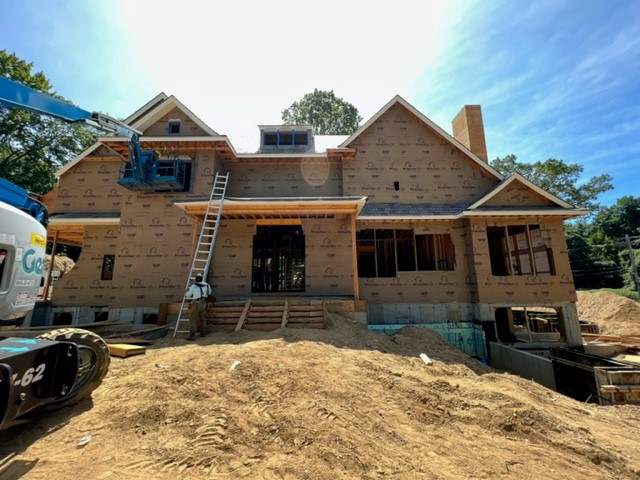Moisture—water or vapor—is the most damaging and detrimental element that can enter the building envelope. Especially moisture in its liquid form, also known as bulk water, such as rain, runoff, and other liquid states, that needs to move out of the assembly. ASTM E2273, standard test method for determining the drainage efficiency of weather-resistive barriers (WRB), doesn’t tell the whole story of the performance required to ensure water is quickly drained out of your assembly.
Understanding Bulk Water & Moisture Management
Bulk water is driven primarily by gravity, wind, and pressure differences. It can enter the building envelope through any openings, cracks, and gaps in the assembly, and collect inside the wall cavity. Water vapor can infiltrate the building enclosure through air-transported moisture and vapor diffusion. This can cause condensation and water to accumulate in the wall cavity.
When water accumulates inside the building envelope, water pressure builds up and can penetrate the WRB and compromise the integrity, performance, and longevity of the home. That’s why when evaluating the efficiency of a WRB, it’s essential to consider how much liquid water can be drained over a short period and how much space there is for drying—the part of the story the ASTM standard doesn’t tell.

HydroGap SA Samples
GET YOUR FREE SAMPLES TODAY OF THE FIRST EVER SELF-ADHERED DRAINABLE HOUSEWRAP
Limitations of ASTM Standards for Drainage Efficiency
In discussing the drainage efficiency of WRBs, it’s crucial to distinguish between the percentage of water that can be drained and the speed at which it happens. As we’ve talked about before, ASTM E2273 is a great starting point and benchmark for the industry, but there are ways we can build beyond that.
The ASTM standard for drainage efficiency measures efficiency using a relatively small amount of water over an extended period (up to 60 minutes), which doesn’t fully address the real-world scenarios where large volumes of water need to be drained quickly—particularly in high-risk areas like around windows, doors, and other flashing details. These areas are more prone to significant water infiltration, and efficient drainage is essential to prevent water from penetrating and potentially causing damage.
For a deeper dive into ASTM standards, their real-world applications, and limitations, read our blog on How to Navigate ASTM Standards.
Time-to-Drain vs. Drainage Efficiency
At Benjamin Obdyke, we use a comprehensive approach to evaluate the performance of our WRBs, using the ASTM standard and then going beyond that by calculating the time to drain. Time to drain measures how quickly water escapes the assembly, a critical metric in assessing the effectiveness of your WRB in managing moisture and bulk water and preventing water retention.
Get the whole story on time to drain vs. drainage efficiency.
Challenges with Traditional Housewraps
Recently, we’ve observed a trend where more flat or conventional housewraps have passed the ASTM drainage efficiency test. Passing the ASTM test doesn’t necessarily mean a housewrap is drainable. To exceed the ASTM standard and ensure superior protection, it’s crucial to consider housewraps that create a true drainage space. By adding a sufficient gap, these wraps can effectively manage water flow, mitigating the risks associated with water infiltration and ensuring the long-term integrity of wall assemblies.
Risk Prevention in Bulk Water Management with HydroGap®
HydroGap and HydroGap SA’s 1-mm spacers create a true drainage space and can effectively drain large volumes of water rapidly, offering 96% drainage efficiency and surpassing the ASTM requirement of 70%. This exceeds some flat housewraps that meet ASTM criteria but might not perform as well under high-water conditions or drain water quickly.
This distinction is crucial for preventing bulk water from building up and potentially causing issues like water ingress at window openings or other vulnerable spots. By ensuring fast water drainage, HydroGap helps mitigate risks and maintains the integrity of wall assemblies, empowering you to surpass the standard for enhanced protection.
Don’t just take our word for it—watch for yourself:
Creating Effective Drainage Spaces
Taking it a step further, rainscreens provide an even larger gap and represent the ideal approach for moisture management and drainage—ensuring that water drains out rapidly while facilitating airflow for drying. Our Slicker Max rainscreen is ideal for providing drainage and ventilation behind fiber cement, stone veneer, and stucco applications. Combine it with BenWrap and HydroFlash GP or HydroFlash LA to get the most optimal rainscreen system.
To exceed ASTM standards and ensure optimal protection against bulk water and water of any state, it’s crucial to implement housewraps and building envelope assemblies that create true drainage spaces. This proactive approach goes beyond just compliance, aiming for enhanced performance and reliability in moisture management.
Order a sample of any of our products today to start building beyond the standard. Or contact us for one-on-one support and expertise.




